1992 VOLKSWAGEN CARAVELLE wheel
[x] Cancel search: wheelPage 123 of 164
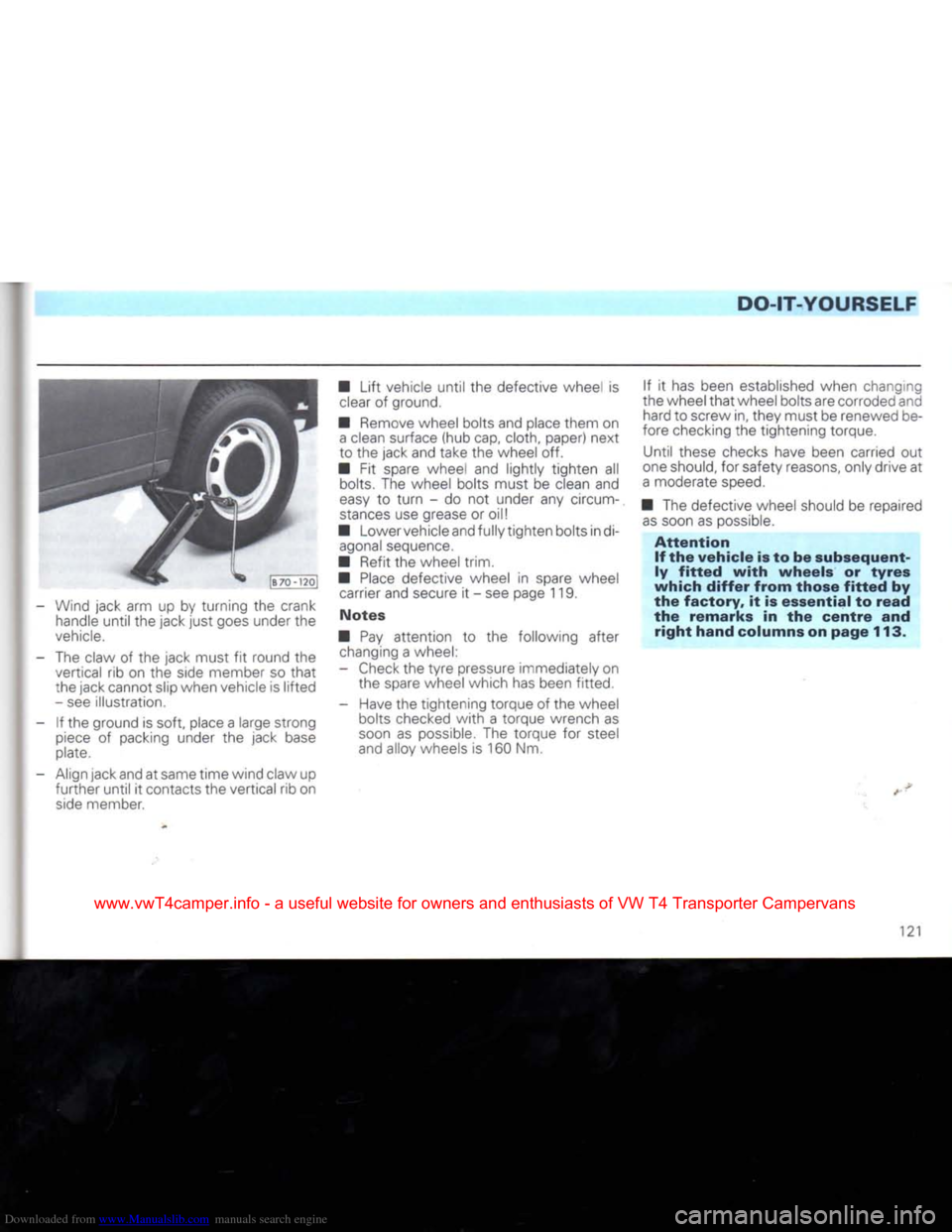
Downloaded from www.Manualslib.com manuals search engine
DO-IT-YOURSELF
- Wind jack arm up by turning the crank handle
until
the jack
just
goes under the
vehicle.
- The claw of the jack must fit round the vertical rib on the side member so
that
the jack cannot slip when vehicle is
lifted
- see illustration.
- If the ground is soft, place a large strong
piece
of packing under the jack base
plate.
- Align jack and at same time wind claw up
further
until
it contacts the vertical rib on
side
member. •
Lift
vehicle
until
the defective wheel is
clear
of ground.
• Remove wheel bolts and place them on
a
clean surface (hub cap, cloth, paper) next
to the jack and take the wheel off.
• Fit spare wheel and lightly tighten all bolts. The wheel bolts must be clean and
easy
to
turn
- do not under any circum
stances
use grease or oil!
• Lowervehicleand fully tighten bolts indi- agonal sequence.
• Refit the wheel trim.
•
Place
defective wheel in spare wheel carrier and secure it - see page 119.
Notes
• Pay attention to the following after changing a wheel:
- Check the
tyre
pressure immediately on the spare wheel which has been fitted.
- Have the tightening torque of the wheel bolts checked
with
a torque wrench as
soon
as possible. The torque for steel
and alloy wheels is 160 Nm. If it has been established when changing
the wheel
that
wheel bolts are corroded and hard to screw in, they must be renewed be
fore checking the tightening torque.
Until these checks have been carried out
one should, for safety reasons, only drive at
a
moderate
speed.
• The defective wheel should be repaired
as
soon as possible.
Attention
If the
vehicle
is to be
subsequent
ly
fitted
with
wheels
or
tyres
which
differ
from
those
fitted
by
the
factory,
it is
essential
to
read
the
remarks
in the
centre
and
right
hand
columns on
page
113.
121
www.vwT4camper.info - a useful website for owners and enthusiasts of VW T4 Transporter Campervans
Page 130 of 164

Downloaded from www.Manualslib.com manuals search engine
DO-IT-YOURSELF
Adjusting
headlights
I he setting of the headlights is very import
ant to traffic safety. The adjustment should
tnerefore only be done
with
a special
appliance.
Note official regulations when
setting headlights.
On vehicles
with
beam
control* the
knurled disc on the instrument panel must
be
in the
basic
position (-).
Both illustrations show the adjustment on
the
right
hand headlight. On the
left
hand headlight the adjustment is symmetrically
opposite.
Main
headlights
The
headlights are adjusted from the
front
with
a suitable Phillips screwdriver
(from
ve
hicle
tools). The bonnet must be released or
open..
A
- Vertical adjustment
Turning clockwise lowers the headlights.
B
- Lateral adjustment
PIPS
|B7Q-
)55|
Fog
lights*
The
front
foglights are adjusted by a knurled
wheel mounted on the foglight behind the bumper. To adjust, push the
flat
end of a
screwdriver through the opening adjacent
to the foglight (see Fig.) and rotate knurled
wheel.
On
vehicles without a spoiler the knurled
wheel can also be turned by hand.
To
reduce the beam range,
turn
screwtothe
left.
128
www.vwT4camper.info - a useful website for owners and enthusiasts of VW T4 Transporter Campervans
Page 134 of 164
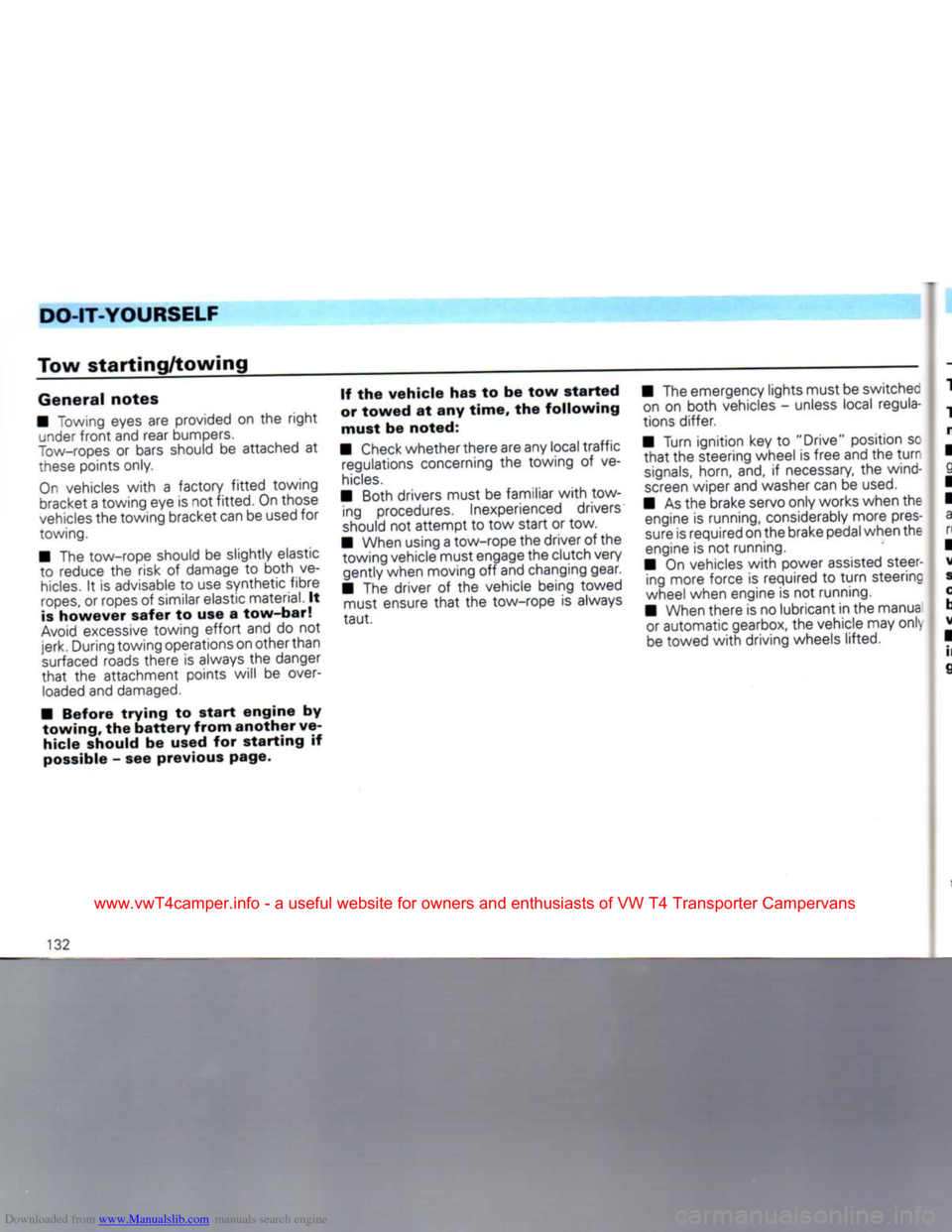
Downloaded from www.Manualslib.com manuals search engine
DO-IT-YOURSELF
Tow
starting/towing
General
notes
• "owing eyes are provided on the
right
under
front
and rear bumpers.
Tow-ropes
or bars should be attached at
these
points only.
On
vehicles
with
a factory
fitted
towing bracket a towing eye is not fitted. On those
vehicles
the towing bracket can be used for
towing.
• The tow-rope should be slightly elastic to reduce the risk of damage to both ve
hicles.
It is advisable to use synthetic fibre
ropes,
or ropes of similar elastic material. It
is
however
safer
to use a
tow-bar!
Avoid
excessive towing
effort
and do not
jerk.
During towing operations on other than
surfaced
roads there is always the danger
that
the attachment points will be over
loaded
and damaged.
•
Before
trying
to
start
engine
by
towing,
the
battery
from
another
ve
hicle
should be used for
starting
if
possible - see previous page. If the
vehicle
has to be tow
started
or
towed
at any
time,
the
following
must
be noted:
•
Check
whether there are any local traffic regulations concerning the towing of ve
hicles.
• Both drivers must be familiar
with
tow ing procedures. Inexperienced drivers
should
not attempt to tow start or tow.
• When using a tow-rope the driver of the towing vehicle must engage the clutch very gently when moving off and changing gear.
• The driver of the vehicle being towed must ensure
that
the tow-rope is always
taut.
• The emergency lights must be switchec
on on both vehicles - unless local regula
tions differ.
• Turn ignition key to "Drive" position sc
that
the steering wheel is free and the
turr
signals,
horn, and, if necessary, the wind
screen
wiper and washer can be
used.
• As the brake servo only works when the engine is running, considerably more pres
sure
is required on the brake pedal when the
engine is not running.
• On vehicles
with
power assisted steer ing more force is required to
turn
steering
wheel when engine is not running.
• When there is no lubricant in the manua or automatic gearbox, the vehicle may only
be
towed
with
driving wheels lifted.
132
www.vwT4camper.info - a useful website for owners and enthusiasts of VW T4 Transporter Campervans
Page 136 of 164
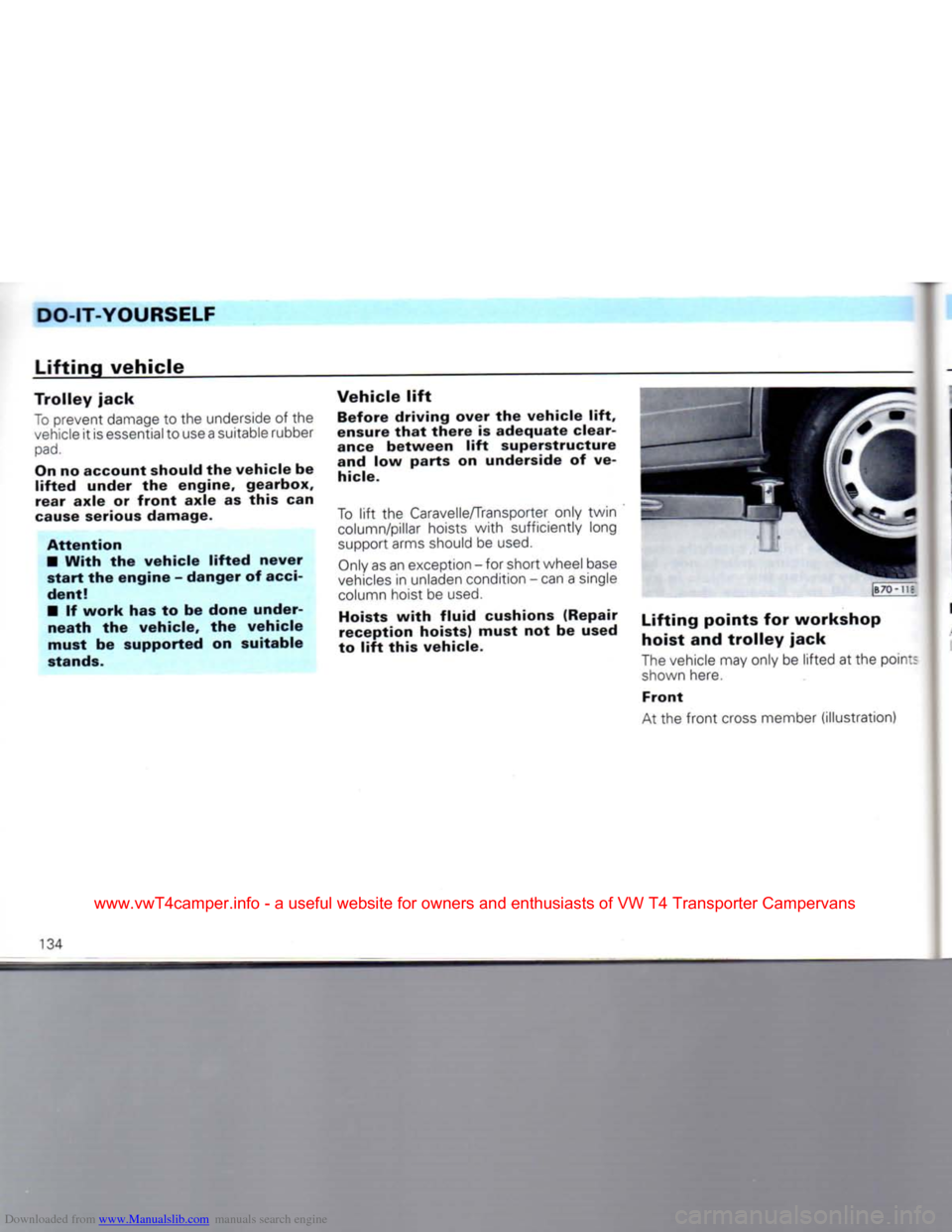
Downloaded from www.Manualslib.com manuals search engine
DO-IT-YOURSELF
Lifting
vehicle
Trolley
jack
To
prevent damage to the underside of the vehicle it is essential to use
a
suitable rubber
On
no account should the vehicle be
lifted
under the engine, gearbox,
rear axle or
front
axle as this can
cause
serious damage.
Attention
• With the vehicle
lifted
never start the engine - danger of
acci
dent!
• If work has to be done under neath the vehicle, the vehicle
must be supported on suitable
stands.
Vehicle
lift
Before driving over the vehicle
lift,
ensure
that
there is adequate clear
ance
between
lift
superstructure
and low parts on underside of ve
hicle.
To
lift
the Caravelle/Transporter only
twin
column/pillar hoists
with
sufficiently long
support arms should be
used.
Only
as an exception - for short wheel base
vehicles
in unladen condition - can a single
column hoist be
used.
Hoists
with
fluid cushions (Repair reception hoists) must not be used
to
lift
this vehicle.
Lifting
points
for
workshop
hoist
and
trolley
jack
The vehicle may only be
lifted
at the poin:
shown here.
Front
At the
front
cross member (illustration) At
us
134
www.vwT4camper.info - a useful website for owners and enthusiasts of VW T4 Transporter Campervans
Page 137 of 164
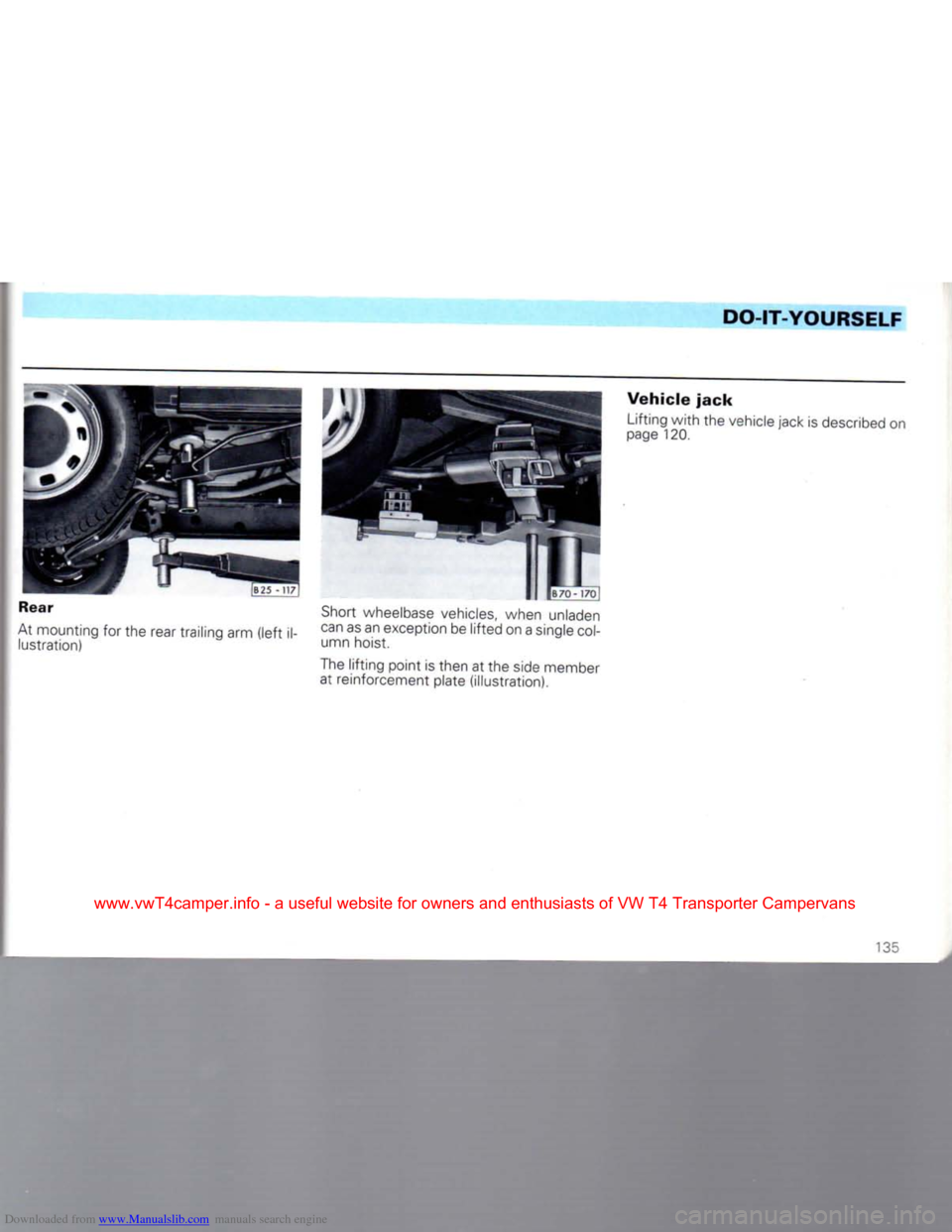
Downloaded from www.Manualslib.com manuals search engine
DO-IT-YOURSELF
Rear
At mounting for the rear trailing arm (left i lustration) Short wheelbase vehicles, when unladen
can as an exception be lifted on a single
col
umn hoist.
The lifting point is then at the side member at reinforcement plate (illustration).
Vehicle
jack
Lifting with the vehicle jack is described on
page 120.
135
www.vwT4camper.info - a useful website for owners and enthusiasts of VW T4 Transporter Campervans
Page 141 of 164
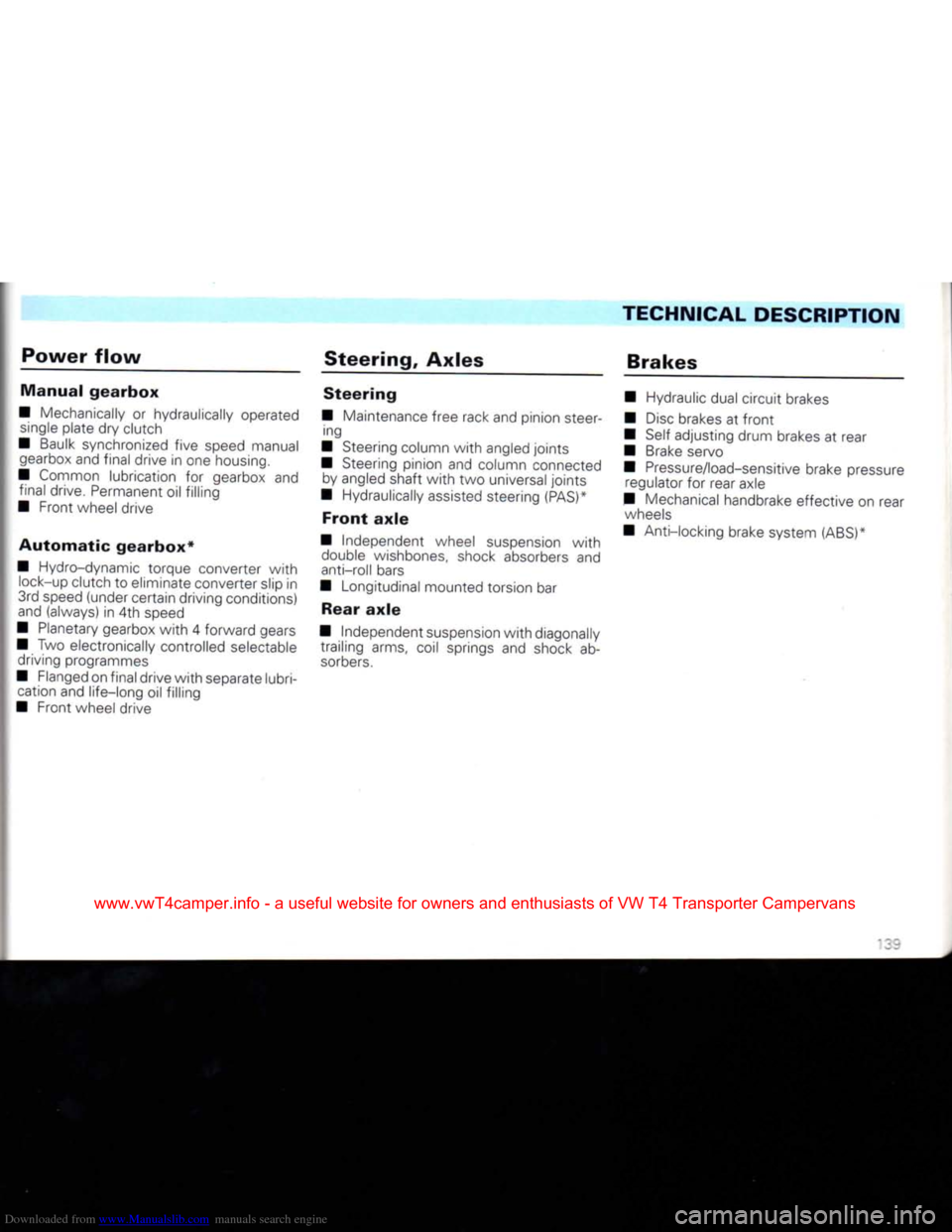
Downloaded from www.Manualslib.com manuals search engine
TECHNICAL
DESCRIPTION
Power
flow
Manual
gearbox
• Mechanically or hydraulically operated single plate dry clutch
• Baulk synchronized five speed manual gearbox and final drive in one housing.
• Common lubrication for gearbox and final drive. Permanent oil filling
• Front wheel drive
Automatic
gearbox*
• Hydro-dynamic torque converter
with
lock-up clutch to eliminate converter slip in
3rd speed (under certain driving conditions)
and (always) in 4th speed
• Planetary gearbox
with
4 forward gears
• Two electronically controlled selectable driving programmes
• Flanged on final drive
with
separate lubri cation and life-long oil filling
• Front wheel drive
Steering,
Axles
Steering
• Maintenance free rack and pinion steer ing
• Steering column
with
angled joints
• Steering pinion and column connected by angled shaft
with
two universal joints
• Hydraulically assisted steering
(PAS)*
Front
axle
• Independent wheel suspension
with
double wishbones, shock absorbers and
anti-roll bars
• Longitudinal mounted torsion bar
Rear
axle
• Independent suspension
with
diagonally trailing arms, coil springs and shock ab
sorbers.
Brakes
• Hydraulic dual circuit brakes
•
Disc
brakes at
front
• Self adjusting drum brakes at rear
• Brake servo
• Pressure/load-sensitive brake pressure regulator for rear axle
• Mechanical handbrake effective on rear wheels
• Anti-locking brake system
(ABS)*
www.vwT4camper.info - a useful website for owners and enthusiasts of VW T4 Transporter Campervans
Page 148 of 164
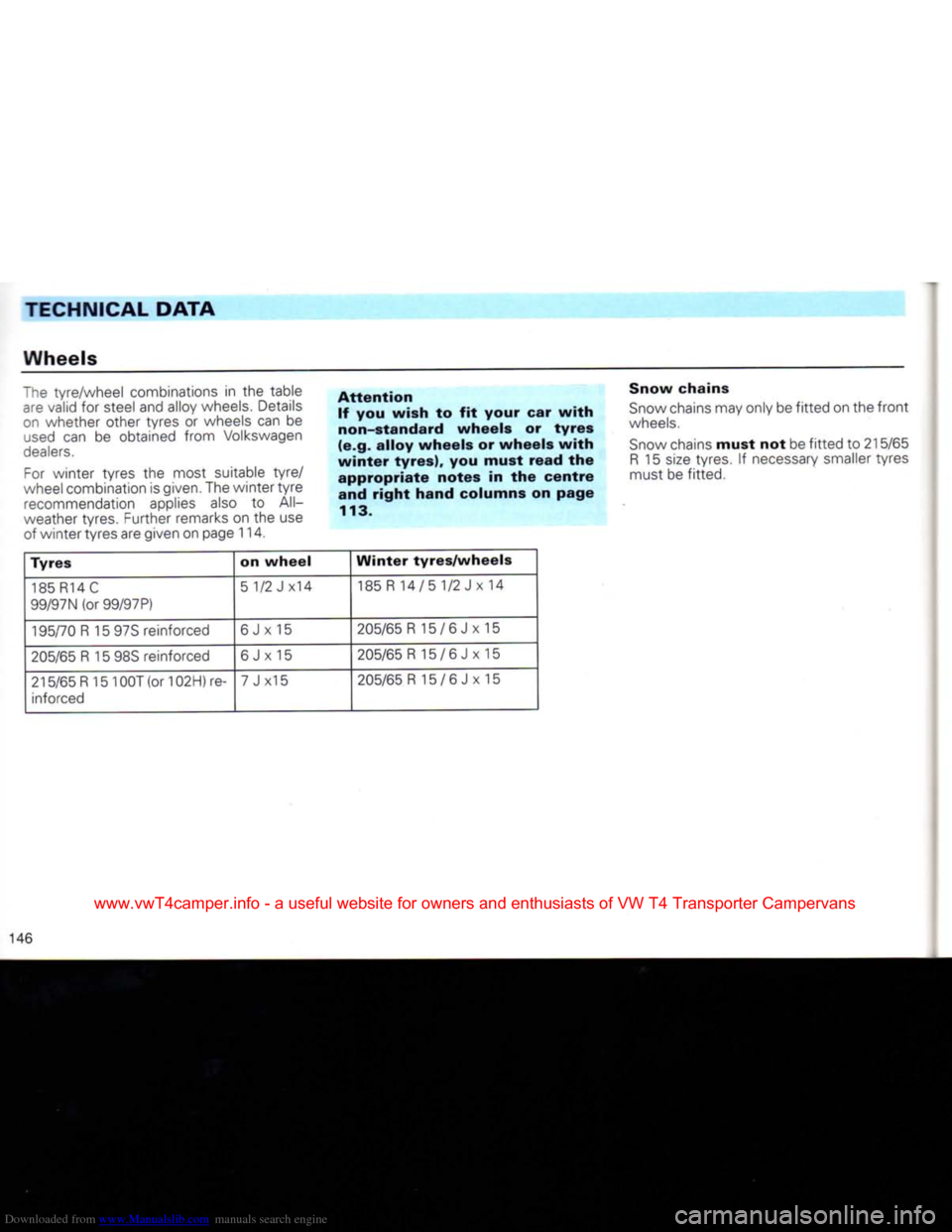
Downloaded from www.Manualslib.com manuals search engine
TECHNICAL DATA
Wheels
The tyre/wheel combinations in the table are valid for steel and alloy wheels. Details
on whether other tyres or wheels can be
used
can be obtained from Volkswagen
dealers.
For
winter tyres the most suitable tyre/
wheel combination is given. The winter
tyre
recommendation applies also to All-
weather tyres. Further remarks on the use of winter tyres are given on page 114.
Attention
If you
wish
to fit
your
car
with
non-standard
wheels
or
tyres
(e.g.
alloy
wheels
or
wheels
with
winter
tyres),
you
must
read
the
appropriate
notes
in the
centre
and
right
hand
columns on
page
113.
Snow
chains
Snow
chains may only be
fitted
on the
front
wheels.
Snow
chains
must
not be
fitted
to 215/65
R
15
size
tyres. If necessary smaller tyres
must be fitted.
Tyres
on
wheel
Winter
tyres/wheels
185
R14 C
99/97N
(or 99/97P)
5
1/2 J x14
185
R 14/5 1/2 Jx 14
195/70 R 15 97S reinforced 6 J x 15 205/65 R
1
5 / 6 J x 15
205/65 R 15 98S reinforced 6 Jx 15 205/65 R 15 / 6 J x 15
215/65 R 15 100T (or 102H) re inforced 7 J
x1
5
205/65 R
1
5 / 6 J x
1
5
146
www.vwT4camper.info - a useful website for owners and enthusiasts of VW T4 Transporter Campervans
Page 150 of 164
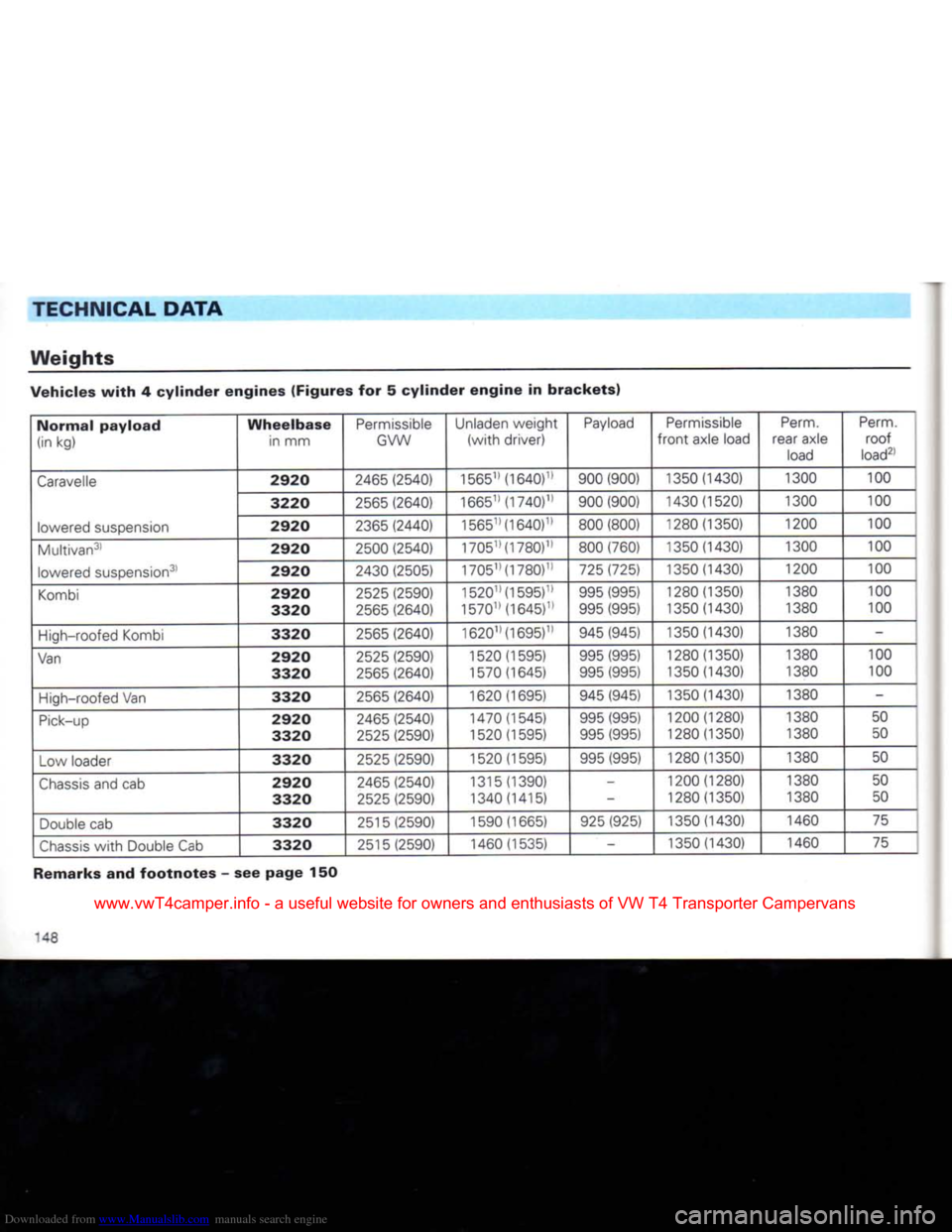
Downloaded from www.Manualslib.com manuals search engine
TECHNICAL
DATA
Weights
Vehicles
with
4
cylinder engines
(Figures for 5
cylinder engine
in
brackets)
Normal
payload
Wheelbase
Permissible Unladen weight
Payload
Permissible
Perm.
Perm.
(in
kg)
in
mm
GVW
(with
driver)
front
axle load rear axle
roof
(in
kg)
load
load2'
Caravelle
2920
2465
(2540)
156511
(1640)11
900
(900)
1350
(1430)
1300
100
3220
2565
(2640)
166511
(1740)1'
900
(900)
1430
(1520)
1300
100
lowered
suspension
2920
2365
(2440)
15651)(1640)1)
800
(800)
1280
(1350)
1200
100
Multivan31
2920
2500
(2540)
17051i(1780)l:'
800
(760)
1350
(1430)
1300
100
lowered
suspension31
2920
2430
(2505)
^os^mo)11
725
(725)
1350
(1430)
1200
100
Kombi
2920
2525
(2590)
15201,(1595)1»
995
(995)
1280
(1350)
1380
100
3320
2565
(2640)
15701'
(1645)1)
995
(995)
1350
(1430)
1380
100
High-roofed
Kombi
3320
2565
(2640)
16201,(1695)11
945
(945)
1350
(1430)
1380
-
Van
2920
2525
(2590)
1520
(1595)
995
(995)
1280
(1350)
1380
100
3320
2565
(2640)
1570
(1645)
995
(995)
1350
(1430)
1380
100
High-roofed
Van
3320
2565
(2640)
1620
(1695)
945
(945)
1350
(1430)
1380
-
Pick-up
2920
2465
(2540)
1470
(1545)
995
(995)
1200
(1280)
1380
50
3320
2525
(2590)
1520
(1595)
995
(995)
1280
(1350)
1380
50
Low
loader
3320
2525
(2590)
1520
(1595)
995
(995)
1280
(1350)
1380
50
Chassis
and cab
2920
2465
(2540)
1315
(1390)
-
1200
(1280)
1380
50
3320
2525
(2590)
1340
(1415)
-
1280
(1350)
1380
50
Double
cab
3320
2515
(2590)
1590
(1665)
925
(925)
1350
(1430)
1460
75
Chassis
with Double
Cab
3320
2515
(2590)
1460
(1535)
-
1350
(1430)
1460
75
Remarks
and
footnotes
- see
page
150
148
www.vwT4camper.info - a useful website for owners and enthusiasts of VW T4 Transporter Campervans